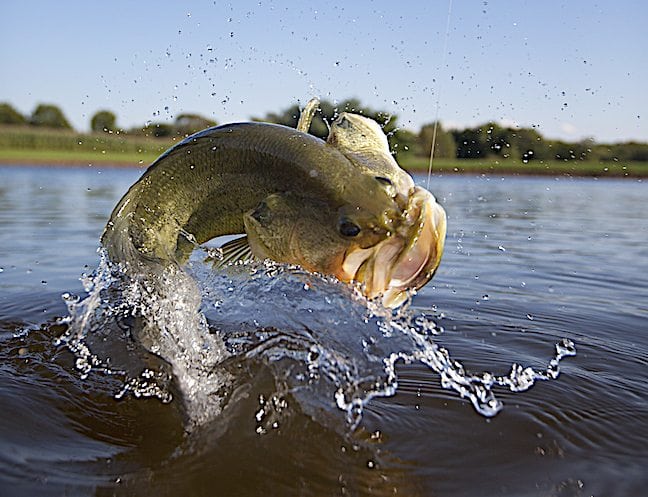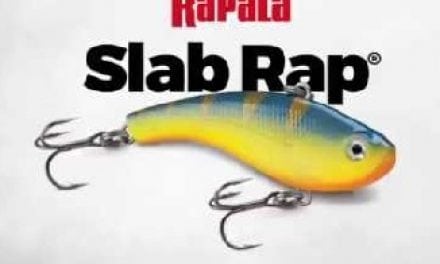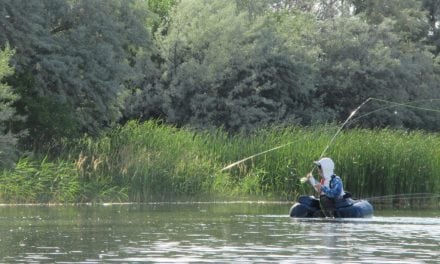Autumn is one of the best times to be on the water, as fall bass become more active and fishing pressure is greatly reduced.
As leaves begin to change colors and the air gives off a crisp hint of cooler weather to come, many sportsmen put away fishing rods to pick up guns and bows. And since pleasure boaters, skiers and others disappear from most waters, bass anglers have little competition or interference.
As winter approaches, bass want to fatten up, which means gorging themselves on high-protein baitfish, such as threadfin shad. Bass often herd baitfish into tight balls and force them toward the surface where bass move in for the kill.

With cooling air creating more comfortable water temperatures and great food sources in the shallows, fall bass can remain active throughout the day.(Shutterstock image)
Feeding bass can erupt suddenly almost anywhere and vanish just as quickly, only to reappear elsewhere moments later as they pursue baitfish. An angler can sometimes spend hours chasing ghosts without putting one in the boat. However, in the right spot, an angler can fill a livewell in minutes.
“Schooling action can be very exciting,” remarked Mark Menendez, professional bass angler. “It can also be frustrating when seeing bass explode on the surface and not taking your bait. Shad migrate to the shallows in search of comfortable water temperatures and moving water. I start fishing the outside portion of the creek channel and continue fishing toward the back of the creek. After the bass have followed the shad to the backs of the creeks, they have them cornered.”
Get ready to crank
Frenzied bass might demolish just about anything hitting the water, but many anglers keep shad-colored lipless crankbaits ready since these baits can sail long distances. Conventional crankbaits, chrome spoons and topwater baits also make excellent temptations for schooling bass.
When bass push shad to the surface, topwaters work even in the deepest water, but traditionally work best in the quiet shallow coves and flats where bass find abundant food. With cooling air creating more comfortable water temperatures and great food sources in the shallows, bass remain active throughout the day and are more likely to hit large topwaters. Some anglers use walking baits that zigzag from side to side, simulating wounded baitfish.
G&F articles on Bass Fishing
- Top 20 Bass Records: How Does Your State Rank?
- Home of Records: California’s Best Spotted Bass Fishing
- Top Picks for Bass Fishing Gear 2017
Although schooling bass might appear instantly and disappear in seconds, they don’t necessarily leave the area. Often, surviving shad disperse and drop deeper to regroup. After slurping the dead and crippled baitfish, bass reorganize for another assault on the shad. When shad go down, continue working the area with jigs or Carolina rigs. Crankbaits resembling shad also make excellent search baits.
“I usually throw a square-billed crankbait from late spring through early fall,” said Gerald Swindle, another professional bass angler. “Very seldom do I just steadily retrieve a crankbait. I don’t jerk a crankbait either, unless I’m trying to clear the grass. The stop-and-go retrieve is probably the most effective way to retrieve a crankbait. I make a few turns on the reel and stop for a few moments. Then, I start winding again.”
In cooler water, anglers should switch to thin, flat-sided crankbaits. With tighter wobbles, these baits closely mimic the shape and movement of threadfin shad.
‘Love to fish jerkbaits’
Jerkbaits fill a niche between topwaters and crankbaits. Jerkbaits look like long, slender crankbaits, with small lips that make the bait dive a foot or two when an angler jerks the rod. Some float while some suspend or slowly sink. When fishing floating jerkbaits, pop the rod to make the lure gurgle on the surface before diving. Then, pause the retrieve so the lure floats back to the surface. Anglers can also reel jerkbaits slowly and steadily. The lip creates an erratic, wobbling action below the surface.
“I love to fish jerkbaits,” commented Randy Howell, former Bassmaster Classic champion. “They’re extremely versatile lures that can be fished in many different situations. Jerkbaits are very good for targeting non-active fish and provoking reaction strikes. I use them in the fall when the water starts to cool and fish start chasing baitfish, but they are effective all year long.”
Slow-sinking or suspending jerkbaits look almost identical to floaters, but feel a bit heavier. These baits often come with rattles for more enticement. Some come with metal pellets that move inside the lure to transfer weight for longer casts. Suspending jerkbaits work particularly well when bass target shad in the fall.
“I prefer suspending jerkbaits,” Howell advised. “When the angler stops the retrieve, it just hovers in the strike zone, giving fish a chance to eat it. When it’s moving, fish often trail it. When it stops in their face, they eat it reactively. To get really good with a jerkbait, fish it with a ‘pop, pop, stop/ pop, pop, stop’ cadence. Pause a couple of seconds between the fall and the start back. That causes the bait to go side-to-side with kind of a walking motion similar to the action of a walk-the-dog topwater bait, but under the water.”
Entice with spinnerbaits
Spinnerbaits can also entice bass from the surface to the bottom all year long. While a spinnerbait doesn’t really look like anything a bass might eat, the whirling blades mimic the flash made by baitfish. The blades also send vibrations pulsating throughout the water column, provoking reaction strikes.
“A bass might spend less than 10 percent of its life actively feeding,” explained Kevin VanDam, four-time Bassmaster Classic champion. “During the rest of the time, bass might strike targets of opportunity, but they are not actively looking to eat something. About 90 percent of the strikes I get are because I triggered an instinct. I want to tantalize that bass into thinking that something is wrong with a baitfish.”
Spinnerbaits come with different blade types. Long and slender willow-leaf blades work better in weedy, shallow flats loaded with abundant entangling cover. Nearly round, Colorado blades create the most thumping vibrations, excellent for fishing slow in murky water. Some spinnerbaits come with combinations of blade types for the most effective action.
“I like a single Colorado or a single willow for slow-rolling,” VanDam said. “A willow-leaf blade will go a lot deeper because it has less water displacement, but doesn’t have as much thump to it. In stained water, use a louder presentation. In stained or muddy water, try to get fish to see the bait from a little farther away, so switch to bright colors.”
Swimbaits act like baitfish
The ultimate shad imitation, a swimbait looks almost exactly like a baitfish. Some swimbaits come equipped with internal weights that make the bait produce enticing wobbles. With others, soft-plastic tails slip over external jigheads.
“A swimbait is so lifelike that it works very well in clear water,” VanDam said. “In really clear water, fish might shy away from a jerkbait or a spinnerbait. Swimbaits are so natural looking that they don’t scare fish.”
Anglers can work swimbaits almost like topwater baits, buzzing them just below the surface or running them through any depth like crankbaits. In deep water, slow-roll them just off the bottom. Anglers can also “worm” them along bottom contours like fishing a Texas-rigged plastic lure.
In the fall, many techniques produce good action because bass aggressively hunt for prey to eat. With so many people doing other things, ardent anglers might find themselves alone at the best spots with only hungry bass for company.
Cast & Blast
Sportsmen who can’t decide whether to fish or hunt can easily do both in a boat. Squirrels see boats all the time and generally ignore anglers.
Canoes, kayaks or other small craft can glide along silently where thick growth makes walking nearly impossible. With a gun in a handy, safe place, ease along a forested shoreline casting for bass while listening for squirrels chattering, leaves rustling, claws scratching on tree bark, acorns dropping to the ground or water and other sounds. Between casts, scan trees for movement or anything that might indicate squirrel activity.
Many people hunt and fish in teams. One person sits in the bow ready for action while the other paddles the boat. This creates an excellent opportunity for children to enjoy the outdoors. In a boat, children can sit in relative comfort and might not become as bored. Moreover, hunters in a boat can carry snacks and refreshments so they can take occasional breaks. — John Felsher
The post Can’t-Miss Lure Tactics to Catch Fall Bass appeared first on Game & Fish.
















